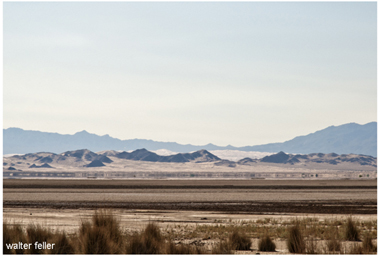Soda Springs
(Hancock's Redoubt)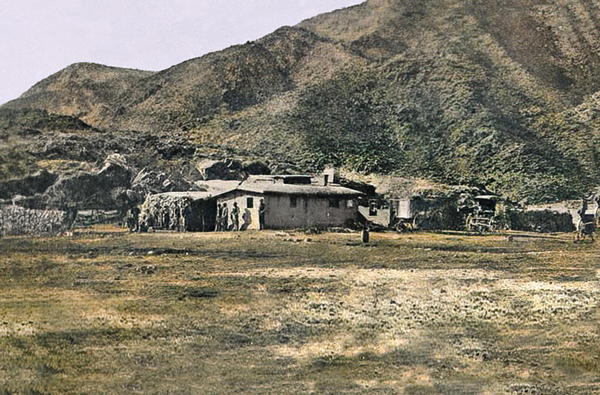
Soda Springs - 1874 -- NPS colorized
This desert camp, variously named for the dry soda lake in its vicinity, was first established south of Baker, San Bernardino County, in the spring of 1860 by men of the 1st Dragoons and called Hancock's Redoubt. Latter, in the spring of 1867, an outpost was maintained there for a few weeks. Then, beginning on August 21, 1867, the site was manned almost continuously as an outpost of Camp Cady, 35 miles distant, until May 23, 1868, when it was abandoned by the Army permanently.
History
Colonel Herbert M. Hart, USMC (retired)Executive Director, Council on America's Military Past
Things at Soda Lake almost got out of hand back in 1863, but "prompt action and determined manner convinced the Indians they had picked the wrong set of opponents.
This was in the interim period between Army posts at what an Army inspection termed "a dried up lake, or sea, whose salts of soda efforesce and whiten the ground like snow for miles in every direction."
In 1860 it had been the site of Hancock Redoubt, a series of breastworks and corrals constructed to protect travelers on the Government Road. It was 35 miles from Camp Cady, the nearest post to the west, and 75 to Fort Beale in the Piute Mountains to the east.
After 1860 most of the posts were not manned, an encouraging situation as far as the Indians were concerned. The scene was set for them, they figured, on July 30, 1863, when a band spotted two government teams with wagons at Soda Lake. The teams were bringing potatoes to Fort Mojave.
"The Indians demanded flour and tobacco as the price of peace," the commander at Fort Mojave reported. "Not having these articles supplied them, they commenced climbing into the wagons to help themselves, when the men with the teams seized their muskets, drove them from the wagons, and their prompt and determined manner induced Indians to lay down their bows and arrows and forego not only the above-mentioned luxuries, but the luxury of a fight also."
Apparently the natives had forgotten the lesson administered to them at Soda Lake three years earlier.
That was during the period of construction of so-called "Fort Soda." While Carleton and his men devoted their main effort to building Camp Cady, a detachment was sent to locate the Indians believed to be in the vicinity of Soda Lake.
Here, in their temporary homes from which they could plunder and ambush travelers, the Indians were surprised by an Army patrol. A desperate battle followed in which the scales of victory tipped to the Army because of the primitive weapons used by the tribe. The Indian casualties were three killed, one seriously wounded, and one woman prisoner. Not long afterward, the Indians asked for a truce.
Hancock Redoubt did not remain in action long after that. Less than a month later, the post was abandoned. It had been intended only as an overnight camp although an officer with the Boundary Commission credited it with a higher stature. "There is a small fort at the sink of the Mojave and another 35 miles above known as Camp Cady, neither of them are garrisoned. They have both been constructed of mud and willow brush and a half dozen resolute men could hold them against all of the Indians combined inhabiting the Great American Desert," he said.
"I am told they were built to afford shelter to small parties of whites traveling through the country who were apprehensive of Indian activities," he added, "but it would seem to me that a party of Indians meditating on attack would have the sagacity to occupy the fort in advance."
When the posts were reopened in 1867, Hancock Redoubt became Fort Soda or Camp Soda Springs. The name is uncertain because it never got into official records. It served in anonymity.
One of its most serious incidents occurred in 1867 when an Army ambulance was jumped by 15 Indians between Soda Lake and Camp Cady. The first shots dropped the escort's horse. The soldier jumped into the ambulance and it broke out for Soda Lake after an hour's fight.
Despite the heavy fire being conducted out the rear of the ambulance, the Indians kept up the pursuit. Every likely ambush spot was manned to Fort Soda, but the ambulance got through. A surgeon who was a passenger in the vehicle was fatally wounded in the fight. He lived only long enough at the fort to write a final letter.
Incidents of another caliber highlighted the history of this short-time post. During the period when the chain of redoubts were being abandoned, the officer in charge at Fort Soda had to report that a private had deserted, "taking the best horse at the post." The horse was not given a chance to prove himself, apparently, because the private was caught a few months later. He had turned gold miner and had located himself at Eldorado Canyon. He didn't know that the same unit provided men for the Mojave Desert forts and various Nevada camps ... including Eldorado Canyon, only a few miles upriver from Fort Mojave.
Additional Notes:
The guardhouse's original walls can be detected for first couple of feet above ground. Original construction was without mortar, but was so solid that it could be built upon with only minor improvement. Unchinked portion of walls is original part; obviously roofs, window, and painted area are new. Building now serves as dining room for California State University Fullerton's Desert Research Center.
Soda lake from Fort Soda was described in 1866 by Army Inspector Rusling as "a vast basin, rimmed around with desolate hills and mountains, and during the rainy season a considerable body of water, indeed, collects here. Soon, however, evaporation does its work, and the lake proper subsides to little or nothing, worth speaking of. When we were there, it was said to be 20 miles long, by four or five wide, though of course everything very marshy or shallow." This was before Fort Soda was re-established and "there was no house or even but there; no person or living thing; and what with the heat, and glare, and awful desolation-I think it was about the most wretched and miserable day I spent everywhere." Rusling suggested situation was complicated by presence of Indian fires in hills during night, suggesting possibility of attack. Even more so, he noted that a rattlesnake had crawled into blankets of member of party, causing uproar when owner arose in morning. "After this," Rusling added, "we usually retired with all our clothes and tallest boots on." This view is across Soda Lake toward Cow hole and Old Dad Mountains and Devil's Playground. In 1871 officer's wife passed here, wrote, "I had no idea that such a forlorn district was comprised within the limits of the United States . . . We traveled 18 miles through deep sand, which is the hardest thing imaginable on the poor mules, for their feet being very small sink deep in, the last few miles being through choking dust." Lake was last full in 1937 when it flooded entire area.
Stone buildings were used by travelers in years after Army left, then by German chemical company in 1910's. Company rebuilt buildings so that modern inspection of site cannot be certain whether buildings date from that period or earlier. Layout and building identifications are based on local legend. Site is 930 feet above sea level, quite a drop from 5079 feet only 42 miles to east near Rock Springs.
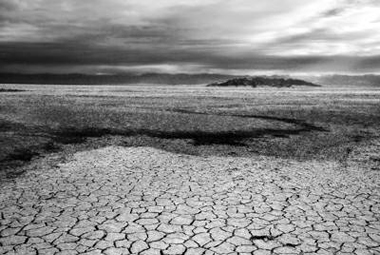
Soda Lake

Mojave Road
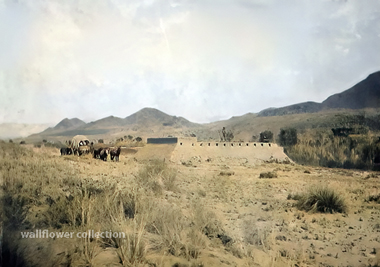
Camp Cady
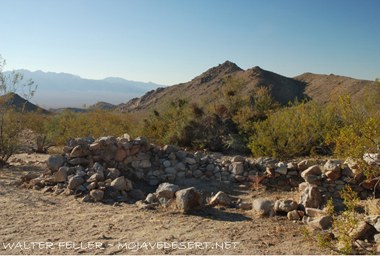
Marl Springs
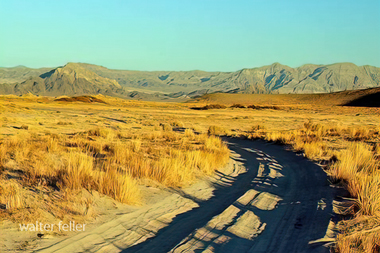
A History of Zzyzx 1860-1870
